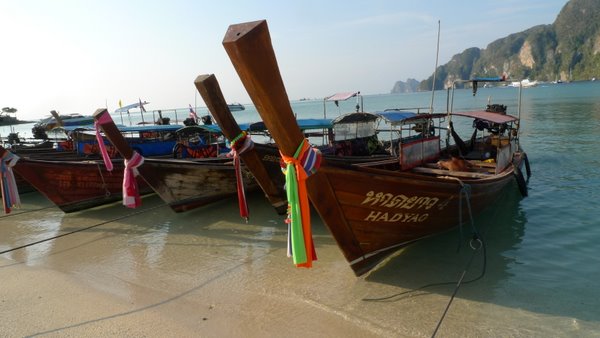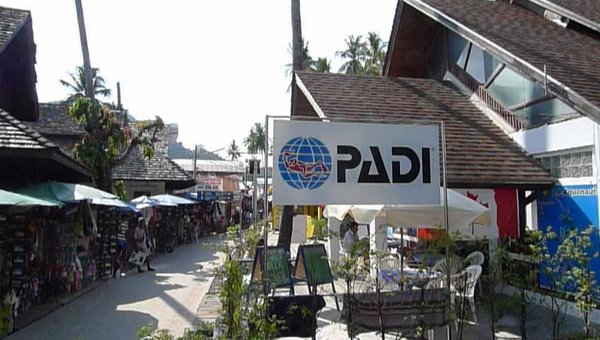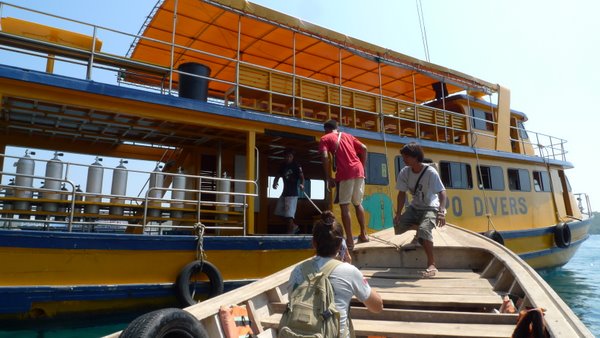Ugh, the dawn of video in 16:9 isn’t being kind to my blog. Word of advice: in your next blog redesign, make sure that your main column width can accomodate HD videos which is at least 560 px in width (560×340). Of course, you can always resize them, but what a hassle!
I recently took part in a media FAM tour of Thailand. Together with a few friends from the online community and the glossies we took a week off to tour BKK, Krabi, the Phi Phi Islands and Phuket. One of the highlights of Phi Phi was making way for one dive.
Phi Phi Island is Thailand’s version of Boracay. It is frequented and inhabited mostly by Europeans. Sadly, the past few years have not been kind to the place due to the Tsunami devastation of 2005. As a Filipino who has the luxury to access virgin beaches (fine let’s include Boracay), Phi Phi’s beach is OK. The view of the bay is breathtaking, albeit the water’s visibility wasn’t anything to write home about. There are two main beaches — the dock, which contains the house reef and the “back” of the island which is sprawled with Europeans with (and without) bikinis. The “back’s” water was green, perhaps due to the season.
I was initially promised a morning of diving, which would accomodate at most two dives. I had brought my AOW (advanced open water) license and luck with me, found a decent looking dive operator right beside the hotel, Aquanauts Scuba. I had a short chat with Hugo, one of the dive masters and probably an owner. He told me that the boat would leave the next day at 7AM, to do two dives out for only 2,500 Baht. That’s around PHP 3,000 for two dives. Diving in Phi Phi seems to be slightly more affordable than in Puerto Galera – but nothing beats Anilao’s rates vis a vis quality! We had a long chat, with me explaining that I was flying out and him taking this into consideration (they do not do decompression dives) while he was asking me about my experience in the past. This is how operators SHOULD work — they get to know more about the diver, his experience, in order to build a safe dive plan.
Here’s a bit about Aquanauts:
Aquanauts Scuba was one of the first purpose-built dive centers to be established on Phi Phi Island, with roots going back to 1989, when the first of our team settled here. Our style is non-commercial and comes from diving in small numbers. It maximises both fun and safety. Quite simply we put quality first when we limit the number of divers per instructor to 4. All dives are planned and supervised to strict P.A.D.I. standards, which are recognised internationally. Personal attention and professional care are corner-stones of Aquanauts Scuba’s beliefs.
A number have asked what certification agency is the “best” for diving. Although it’s really up to you, PADI is the most ubiquitous so even if you forget your license, a PADI-certified operator can always look you up on their Internet database.
Set on doing this dive, I went back to the tour operator informing the group of my plans to leave early the next day. I was made a counter-offer instead to do two dives out for only 2,000 Baht. With a little savings, why not? The operator knew someone — probably a local. The following mental processing was going on in my head: he’d probably know a local, which meant he’d know the nice areas. And it’s cheaper. Plus safer. I’ll take his word!
If I went with Aquanauts, I’d miss the island hopping tour. Weighing both options, it seemed like this would be fine as since the group is there as media, I’d be able to cover the better Phi Phi dive sites since I had an underwater camera. Nobody else in the group would be able to do this.
After the island tour (we went to the island where The Beach was shot) I proceeded to an operator called Hippo Divers. One of the media guys from Indonesia joined me. I stepped into the operator’s hut and that’s when it dawned on me that I wasn’t going to be joining a dive out — but rather an introduction dive. Ugh. From two dives promised to me, it was down to one and not in one of the more pristine areas of the islands, but within the house reef.
Our tour operator highlighted safety but what I saw done to my colleague wasn’t very safe. There’s a language barrier in Thailand. Despite a good number of the population knowing English, it isn’t as prevalent like in Manila, Malaysia or Singapore. This is what happened: there’s a binder with pull out pages with illustration on how to equalize, clear your mask and breathe through your regulator. My colleague was asked to read it. For crying out loud, what happened to the “safety” we were promised? It’s a good thing we were only at the house reef, and at 30 feet. But still. That’s not the point. So we geared up. I jumped in first. Then my Indonesian friend with his dive master. Then we went down. Of course he had problems.
* At this point I want to make it clear that this isn’t a post against Hippo Divers. It’s a commentary on the snap diving instruction methods. This also happens in the Philippines. Diving is skills based so you need to get the skills right before you start going underwater. In my first intro dive about three years ago I was pulled around the bottom of the (dirty) reef in Puerto Galera. I wanted to equalize but the dive master really didn’t mind me. It sucked more here due to the language barrier.
Here’s my beef: I was really disappointed with not being informed of what I was getting into. Rather than save money, I spent a lot more to see … well, less. I have no complaints about the actual dive (the regulator was a bit faulty though — turn my head to the right, and water would seep in). So again, my beef is with not being properly informed. Had I known I was going to do the house reef, at least I would have been left with the option to back out (I still would have gone though, haha!).
Anyway, do check out the video above. Mostly hard corals and schools. Not sure why they feed the fish. Must be a treat to first timers. Ironic too — I was in BKK precisely for a conference on Tourism and one of the rules for marine tourism was “do not feed the fish.”
I think operators who run intro driving stints should be more prudent in quantity (vs. quality) “sweat shop intro dives”. It almost looks like a fly by night. Here’s a tip: when doing an intro dive, I suggest getting a dive instructor who doesn’t directly work for a resort. Find a friend who knows a DM and get that. You will be guaranteed a better first time experience from someone who doesn’t treat it like work. I was fortunate to find a great instructor through a friend (Jan Acosta) and it is his fault why I’m so addicted to diving! I’m on my one year anniversary!
I’d like to extend a huge thanks to Dave de Jesus of the Tourism Authority of Thailand for an overall great one week experience in Bangkok, Krabi, Phi Phi and Phuket.



